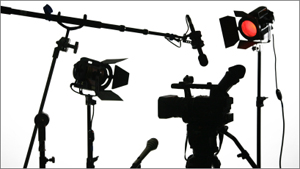Choosing Video Equipment: What Really Matters?
by
 We’ve been getting a lot of questions about which cameras to buy for filming in the lab. There are a dizzying array of camcorder types and functionalities available these days. Sites such as cnet provide general information in addition to detailed reviews on specific makes and models.
We’ve been getting a lot of questions about which cameras to buy for filming in the lab. There are a dizzying array of camcorder types and functionalities available these days. Sites such as cnet provide general information in addition to detailed reviews on specific makes and models.
Here we help sort through the information in order to focus on a limited number of functions relevant to filming in the lab.
Camera
Standard vs. High definition.
Increased resolution also means increased file size and increased price. Although, our footage is shot in HD, we compress it to standard definition prior to uploading. The smaller file sizes are easier to work with and clearly convey the lab experiments at hand. For HD on a budget, Flip and other manufacturers now make HD camcorders for under $200.
Our recommendation: Generally, things are moving towards HD these days. However, with the exception of the crop of compact cameras mentioned above, the price points are still high. A standard definition camera will be provide plenty of resolution for capturing your lab experiments.
DVD, Hard-drive, Mini-DV, or Flask drive
DVD – camera records straight to a miniDVD. If purchasing an HD-DVD camera, be aware that you’ll need a Blu-Ray player to watch the footage.
Hard drive and Flash – Camera records straight to an internal drive or card.
- Advantages – no tapes required; rapid download to computer.
- Disadvantages – once hard drive is full, need to download footage; accidental drop may destroy footage. Flash has limited storage capacity.
Mini-DV – camera records to mini tapes
- Advantages – tapes are good for archiving and they’re more stable in the event of an accident; footage easily downloads to computer
- Disadvantages – footage downloads in real time.
Our recommendation: While hard drive cameras may provide the most convenient mix of download speed and storage capacity, you may catch a price break on the Mini-DVs.
Function
There are a number of functions offered on cameras these days. Both of these are nice-to-have, not need-to-have:
Microphone jack – It’s increasingly difficult to find camcorders with external mic jacks. Part of this is due to improvements in cameras internal microphones. If choosing between two cameras and one has a mic jack, go with the jack.
Image stabilization – This feature helps reduce camera shake and is very common, but not all manufacturers do it well. Although a tripod completely stabilizes the camera and eliminates the need for this function, handheld zooms may benefit from the stabilization.
Our recommendation: If any of the finalists in your camera search have these functions, weigh these heavily.
Accessories
Tripod – stabilizes all shots, giving steady footage. In addition to stability it also allows individuals to film themselves. These are available as low as $15.
Lavalier microphone – as discussed above, if your camcorder has one, take advantage of it. When ordering, pay attention to the length of the cord. Five feet is not enough…we’ve made that mistake… Starting at $15-20.
Wide-angle lens – Most commercial camcorders are threaded around the lens, allowing for lenses to be added. The wide-angle helps get a full shot when in small spaces. When ordering, be sure to look up the diameter of the lens on your camera. They vary model-to-model, so you’ll need to find the wide angle that fits. Prices vary depending on manufacturer. Lens start around $30 and go up.
Protective lens – these UV protective lenses help minimize scratches and damage when shooting. Screw them on to the outermost lens to guarantee no solvent splashing sends your camera to an early grave. These can be found for around $5.
Our recommendation: These are all optional, but we’ve listed them in order of importance.
Where to Buy
We’ve had great luck with B&H photo (no, we were not paid to say that…) but we’re always on the lookout for others – please let us know of you favorites!
Have any other suggestions? Any additional tips on selecting camera equipment for shooting lab experiments?

